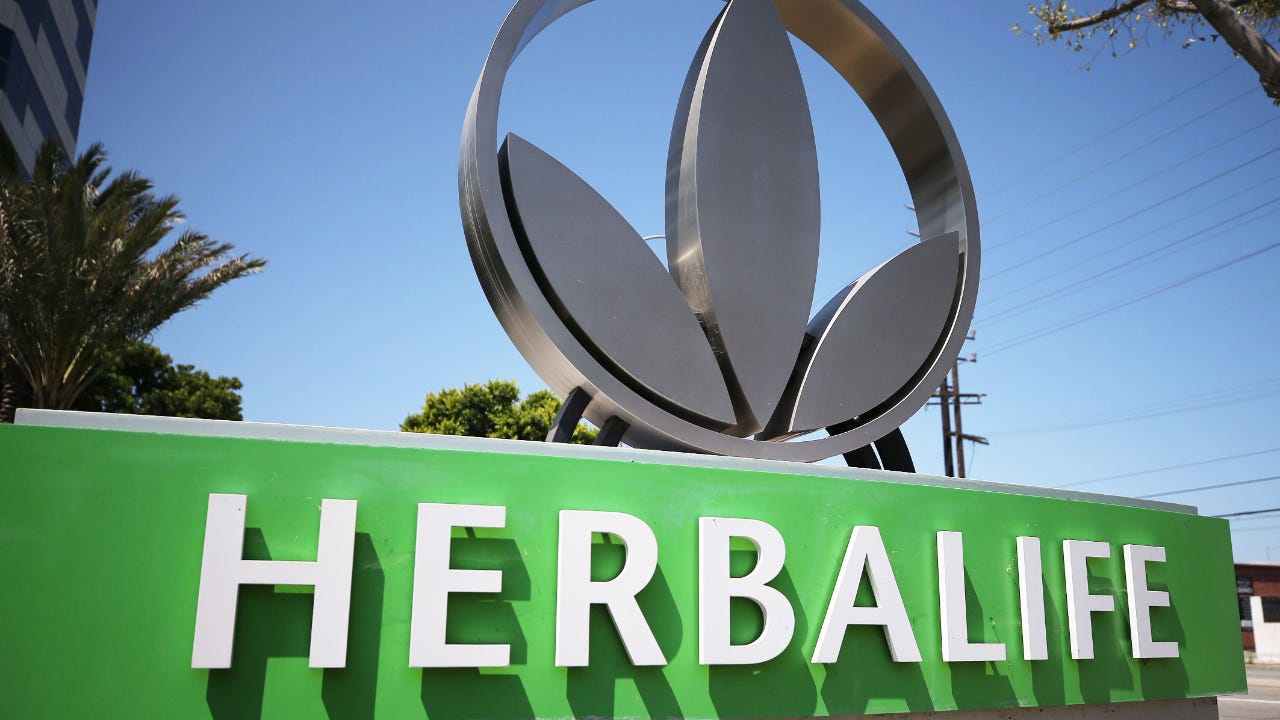What is multi-level marketing?

The Bankrate promise
At Bankrate we strive to help you make smarter financial decisions. While we adhere to strict , this post may contain references to products from our partners. Here's an explanation for .
Multi-level marketing (MLM) is a business model that uses contractors to promote the company’s products or services. Rather than using a traditional salesforce, multi-level marketers such as Amway, Herbalife, Shaklee and others employ third parties as a kind of external salesforce.
These individual members are compensated in two ways: commissions from selling products directly and commissions from the sales of the members they’ve recruited. The commission from their recruits is called a “downline,” and it’s usually the most lucrative element of a multi-level marketing company’s compensation structure, making it valuable to recruit productive members.
Key insights
Facts about MLMs:
- Participation in MLMs is prevalent, with 7.7 percent of American adults having participated in one, according to a 2018 study by AARP.
- About 47 percent of respondents in the AARP survey reported that they lost money by participating in the MLM, while only 25 percent reported making a profit.
- About 7.3 million Americans participated as direct sellers in 2021, a decline of 5.2 percent from the year before, says the Direct Selling Association.
- Of those 7.3 million Americans in 2021, 6.8 million participated in direct selling part-time, according to the Direct Selling Association.
- Direct sales accounted for total revenue of $42.7 billion in the U.S. in 2021, growing 6.4 percent year over year, according to the Direct Selling Association.
- The top sales categories for MLMs in 2021 include wellness, services, home and family care, personal care and clothing, says the Direct Selling Association.
- About 48 percent of participants in an MLM were between 18 and 25 years old, with the average age of a first-time member of 29 years old, says a 2018 AARP report.
- Around 44 percent of participants stayed with the MLM for less than a year.
- About 66 percent of MLM participants invested less than $1,000 for inventory, training and materials while with the organization, says AARP, but individuals can easily spend thousands more if they go full time and buy inventory, attend training and travel.
How MLMs work
- Participation in MLMs is prevalent, with 7.7 percent of American adults having participated in one, according to a 2018 study by AARP.
- About 47 percent of respondents in the AARP survey reported that they lost money by participating in the MLM, while only 25 percent reported making a profit.
- About 7.3 million Americans participated as direct sellers in 2021, a decline of 5.2 percent from the year before, says the Direct Selling Association.
- Of those 7.3 million Americans in 2021, 6.8 million participated in direct selling part-time, according to the Direct Selling Association.
- Direct sales accounted for total revenue of $42.7 billion in the U.S. in 2021, growing 6.4 percent year over year, according to the Direct Selling Association.
- The top sales categories for MLMs in 2021 include wellness, services, home and family care, personal care and clothing, says the Direct Selling Association.
- About 48 percent of participants in an MLM were between 18 and 25 years old, with the average age of a first-time member of 29 years old, says a 2018 AARP report.
- Around 44 percent of participants stayed with the MLM for less than a year.
- About 66 percent of MLM participants invested less than $1,000 for inventory, training and materials while with the organization, says AARP, but individuals can easily spend thousands more if they go full time and buy inventory, attend training and travel.
While they often get a bad rap, multi-level marketing companies are a legitimate business type that is recognized as legal. They’re a popular structure for businesses that rely heavily on sales to consumers, and they use the power of a salesperson’s social network to move – some might say foist – products.
Multi-level marketers need a motivated salesforce, and they’re looking for contractors, direct sales people and others who want to be independent business owners to sell their products.
MLMs structure their compensation system to encourage sales but also the recruitment of other salespeople. While the compensation structure differs from company to company, MLMs generally offer a commission to their contractors for selling products as well as a commission on the sales of those they’ve recruited into the organization.
The compensation from the sales of recruits can be highly lucrative. This downline encourages the recruitment of new salespeople but also encourages the sponsor to manage and even mentor the new recruits so that they can bring more compensation. If those recruits then recruit others into the organization, it can create a powerful downline.
So in MLMs, those at the top of the sales organization can reap significant rewards, while those near the bottom may earn little or nothing, or may even lose money. While an MLM may seem like a way to make easy money, there are much better ways to make passive income.
Pros and cons of MLMs
While MLMs are often derided, they’re a legitimate business structure with advantages and disadvantages to the organization and the third-party salesforce.
| Pros | Cons |
|
|
Investing in MLMs
If you’re thinking about participating in an MLM, you should understand the costs and potential benefits of doing so. An MLM’s plan should give you all the relevant information to make a decision, but it may not. Here are some things to watch out for if you’re investing in an MLM.
You’ll often need to make some kind of investment to participate in the MLM. Some may charge modest start-ups fees, require minimum inventory levels or sell training and sales leads.
Depending on which MLM you’re working with and their requirements, it can take substantial money to get going. For example, AARP surveyed MLM participants and found that:
- About 66 percent of MLM participants invested less than $1,000 for all inventory purchases, training, and materials during the period they were involved with the MLM.
- Around 24 percent spent between $1,000 and $4,999.
- About 11 percent paid $5,000 or more.
- A further 23 percent did not remember how much they invested.
- Only four individuals reported spending over $50,000.
And those investments don’t guarantee your success, but neither does working a huge number of hours. Participants who put in significant hours both lost money and also earned the most, according to an AARP study (chart below).
MLM definitions
MLMs use many terms that are common to them, but that are less typical in most businesses. Here are some of the key terms that you might encounter when dealing with an MLM.
- Plan: The plan lays out how salespeople can earn money in the organization, including on their sales and from those they recruit into the MLM. It also details minimum investments that a recruit needs to make and other relevant information to participate.
- Sponsor: A sponsor is a distributor in the MLM company who recruits another into the organization, trying to create a profitable downline.
- Recruit/Partner: This is a contractor who has been recruited into the MLM organization by the sponsor.
- Distributor: A distributor may sound like a fancy title, but it’s what many MLMs refer to their salespeople as.
- Downline: The downline is the people a sponsor has recruited into the organization as well as those they’ve recruited and so on, but the ability to earn commissions on a downline may be capped at a certain number of levels by the MLM. Downline also refers to the compensation that a sponsor receives from the sales commissions of their recruits.
- Upline: The upline is the salespeople above the recruit in the organization, all the way to the top, and a portion of a salesperson’s commission flows to the upline.
Those are some of the most typical terms you’ll find as you research MLMs.
The legality of MLMs and pyramid schemes
MLMs are a legal business organization type, but if they’re structured incorrectly, accidentally or on purpose, they can be considered pyramid schemes, which are illegal.
- MLMs make money through the sales of legitimate products to the general public as well as people in the organization. Compensation to those in the business is based on sales.
- Pyramid schemes rely on recruitment to drive money through the organization rather than sales. New recruits may be forced to pay significant money to participate or may be required to invest significant nonrefundable money in inventory to take part. One typical sign is whether the reward for recruiting new members is more than selling products.
Sometimes it can be difficult to distinguish between a legitimate MLM and a pyramid scheme, because fraudsters obscure how you’re compensated and how the organization is structured. The Federal Trade Commission (FTC) regularly investigates MLMs and seeming pyramid schemes to see if they are fraudulent and then shuts them down if they’re illegal.
MLM examples
Multi-level marketers offer many different products and are some of the most well-known brand names in the marketplace. Here are some of the most popular MLMs and key facts about each.
Amway
Amway is the world’s largest multi-level marketer, and it reported sales of $8.9 billion in 2021, a gain of 4 percent from the prior year. Amway charges $76 annually to be an IBO (independent business owner) and does not require members to buy products or services to become or remain an IBO. Amway reported other key facts about its membership:
- “In 2021, 33 percent of all U.S. registered IBOs had no reported sales, did not sponsor another IBO, and did not earn any compensation from Amway.”
- “62 percent of all U.S. registered IBOs in 2021 received a payment from Amway in at least one month for sales that occurred during 2021.”
- “Of the IBOs who received a payment from Amway in one or more months here is what they annually earned before expenses:
- The Top 1 percent earned $87,901 (average) and $55,264 (median)
- The Top 10 percent earned $14,537 (average) and $4,645 (median)
- The Top 50 percent earned $3,414 (average) and $631 (median)”
Herbalife
Herbalife is a publicly traded company known for its protein shakes and other nutritional products. There is only one required purchase, an initial distributorship kit, which costs $94.10.
Herbalife reported other key figures in 2020 about its first-year distributors, who number about 30,000:
- The top 50 percent earned more than $201 in a month.
- The top 10 percent earned more than $1,246 in a month.
- The top 1 percent earned more than $5,913 in a month.
For all other U.S. distributors, which numbered about 60,000 in 2020, the results were:
- The top 50 percent earned more than $264 in a month.
- The top 10 percent earned more than $3,305 in a month.
- The top 1 percent earned more than $16,213 in a month.
The Federal Trade Commission (FTC) settled a long-running dispute with Herbalife in 2016 over what the FTC called the company’s deceptive business practices. The FTC alleged that Herbalife led potential distributors to believe that they could earn substantial money. As a result, Herbalife agreed to restructure its business and pay $200 million to compensate consumers.
Tupperware
Tupperware is another publicly traded company, and it’s well-known for its eponymous line of food storage containers and cookware. Tupperware charges a fee for their basic business kit, which can range from $15 for the all-digital kit to $119 for the deluxe version with products. But then you’re also on the hook for minimum purchases every few months to remain an active distributor. So you’ll have to keep selling to overcome that hurdle, or you can do what many MLM distributors do and use the product yourself if you can’t sell it.
Avon
Avon is well-known for its line-up of cosmetics, and it’s one of the oldest companies on this list. You’ll need to put up a little bit of money to get started with a welcome kit, which includes some basic cosmetics, brochures, bags and order forms.
Avon has been hit with numerous lawsuits in the past decade, including suits that have alleged that the company has discriminated against pregnant women, used talc-based products that contained asbestos and misled investors about its success in China and Latin America.
Mary Kay
Mary Kay is also known for its cosmetics and its flamboyant founder Mary Kay Ash. As a distributor, you’ll receive a 50 percent discount on the full retail price of your products and you sell the product for full retail price and pocket the difference. Of course, if you like the product, you can also sign up as a distributor and buy it for yourself.
Mary Kay discloses the following facts about its Canadian operations, which should more or less reflect its operations in the U.S.:
- In 2020, 84.8 percent of its consultants were not eligible to earn commissions, because they had not invited at least one other consultant into the organization.
- About 13.4 percent of consultants earned an average commission of $255 in 2020.
- Independent sales directors, about 1.7 percent of all consultants, earned an average of $24,084 in commissions in 2020.
- Independent national sales directors, about 0.044 percent of all consultants, earned an average of $151,032 in commissions in 2020.
Bottom line
MLMs provide a legitimate way for people with real sales ability to make a lot of money, but most people who participate in them won’t enjoy that result and end up losing money. It may cost a lot of money to participate in an MLM, and if you’re not really careful, you may wind up taking part in an illegal pyramid scheme. So it’s important that you understand the risks and fully research any MLM that you’re considering investing your time and money into.
Editorial Disclaimer: All investors are advised to conduct their own independent research into investment strategies before making an investment decision. In addition, investors are advised that past investment product performance is no guarantee of future price appreciation.
Related Articles



